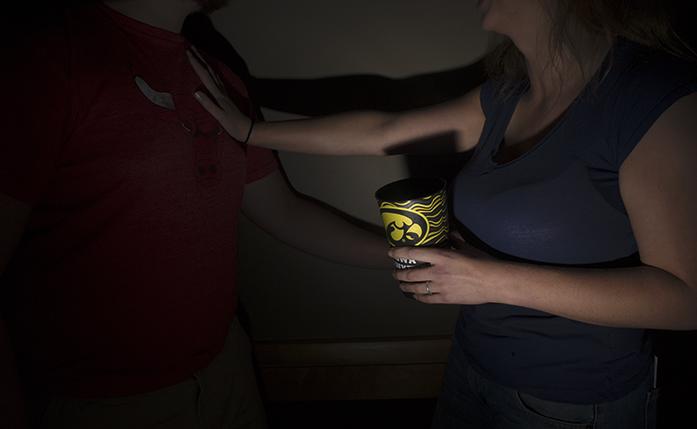By Anders Frieberg
[email protected]
“My Cup Is Not My Consent” is catchy, but the message is clear.
The Rape Victim Advocacy Program began rolling out a new sexual-assault prevention campaign for the school year on Sept. 15, “My Cup Is Not My Consent.” The new campaign will focus on showing students the connection between alcohol and sexual assaults.
The move will feature campaign messages posted on table cards, posters on residence hall doors, cards sent to students in their mail boxes and to greek houses, and free stress balls with the message printed on it.
In addition, QR codes on cards lead to an informational video supporting asking for consent before any sexual activity.
The UI’s policy on sexual misconduct defines “persons who are incapacitated due to the influence of drugs, alcohol, or medication” as “unable to give consent.”
University Sexual Misconduct Response Coordinator Monique DiCarlo said that in the past, university has required an online class for freshmen and efforts during Orientation to help combat sexual assault.
“One way we combat sexual assault is to continuously review our policies and procedures and ensure they keep victims safe and to hold those who are found responsible accountable for what they’ve done,” DiCarlo said.
DiCarlo said the national attitude toward sexual assault on campuses has shifted, and staff members no longer say that only women are victims and men are perpetrators.
“We’ve shifted our prevention methods to be in line with research-informed interventions, like bystander education,” DiCarlo said.
Susan Junis, prevention education coordinator at the Rape Victim Advocacy Program, said people who identify as transgender have the highest rate of victimization.
One in 5 women will be assaulted while in college, and 1 in 16 men will be sexually assaulted, Junis said.
“Offenders often target their victims by looking for vulnerabilities — using alcohol or drugs as a way to control,” DiCarlo said. “If you’re in a group that has social norms that suggest objectifying or being disrespectful to people, particularly hypersexualizing women, that can put you at risk for committing sexual violence.”
While the rates of sexual violence against people who identify as transgender are the greatest, the highest overall number of assaults is against women, Junis said.
The UI has several other resources to combat the issue, including the Women’s Resource and Action Center.
“One of our most common workshops is bystander intervention, focusing on how we recognize red-flag behaviors that perpetrators engage in,” said WRAC violence-prevention-coordinator Meagan Schorr said. “We focus on recognizing alcohol and isolation as two of the biggest red-flag warning signs.”
Schorr said the program explores all kinds of different methods that can prevent an assault. Tactics range from creating a distraction to group intervention to using humor.
“We’re trying to remind students of the university’s consent policy — that if someone is intoxicated, they cannot give consent,” WRAC violence-prevention-specialist Khirin Carter said.
The prevention educators are also working with bar staff to recognize problematic behavior as part of an initiative called Raise the Bar. This training is the same that is directed at university students: bystander intervention.
Above all, consent was stressed.
“We don’t see consent in many scripts — in Disney princess movies, or romantic comedies, or any movie in which people are engaging in any kind of sexual activity,” Junis said. “You never hear ‘Can I kiss you?’ in a movie.”
“The idea of asking for consent isn’t very normalized in our culture, but it is easy to do and ensures both partners are willing to take part in this activity,” she said.



